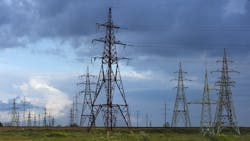Five years ago, a video went viral on social media showing transmission towers playing jump rope with the transmission lines. The video was silent but when the tower hits the ground, you would hear a thud in your head. This phenomenon is known as synesthesia, when your senses get crossed in the brain.
There is no denying that transmission lines can move (almost) like that, sound or no sound when they gallop. They don’t quite jump rope, but they can move enough to cause equipment and pole damage. The flashover from phase-to-phase contact created by the large amplitude displacement can cause burns and damage to wires.
This January, my home utility Evergy shared a video of galloping lines as a result of high winds during some January weather. Evergy does a wonderful job of educating customers and keeping them informed about outage restoration, sharing videos, photos and specific details on social media. Actually, our entire industry does a great job of this, as I monitor utility activity across our nation every day.
This brings me to our cover story this month. New York Power Authority is employing a cool new technology for transmission line monitoring that uses a kind of fiber-optic sensing to find conditions in real time. The technology, created by an Israel-based startup, uses existing fiber-optic ground wire that sits on top of lines to connect the ground wire to an optical interrogator in the substation. I will let you read the article to see more about how it really works. But it can identify galloping lines and icing; it looks at cable characteristics along with the correct weather conditions. The technology has other potential applications as well, such as wildfire prevention and physical security.
Let’s Talk Substations
Speaking of physical security, just about everyone in our industry knows about the infamous Metcalf substation attack in 2014 when gunmen fired on a PG&E facility, causing more than $15 million worth of damage. Physical attacks on the grid in 2022 were at their highest level since 2012, as Senior Editor Jeff Postelwait discussed in his March 2023 article on physical security. Duke Energy, Puget Sound Energy and Tacoma Public Utilities were some of the bigger utilities that encountered substation attacks that year. In fact, a physical attack on a substation that could cause localized outages is more likely to happen than another “Carrington” event, the large geomagnetic storm of 1859 that caused
telegraph systems to fail.
After the Metcalf attack happened, NERC enacted the NERC CIP-014 standard, to “identify and protect transmission stations and transmission substations, and their associated primary control centers, that if rendered inoperable or damaged as a result of a physical attack could result in instability, uncontrolled separation, or cascading within an interconnection.” The rule was purposefully broad and vague. After the 2022 attacks, FERC called for NERC to expand the standard’s applicability, but NERC didn’t recommend expansion. Based on available data, NERC said it found no evidence that expansion of the criteria would identify additional substations as critical.
Chris Ott, a substation security expert interviewed in this issue, contends that NERC CIP-014 can apply to all substations. He joined a utility shortly after the Metcalf attack, and quickly became the subject matter expert due to his military experience in the Marine Corps and knowledge of grid architecture. Ott shares a ranking system for substations based on the NERC CIP-014 standard, as well as how digital twin technology can help utilities be more proactive.
Nature is another “bad actor” when it comes to reliability in substations and other energy facilities. This marks the third anniversary of the Texas power crisis of 2021, when Winter Storm Uri caused an energy infrastructure failure that left 4.5 million without power. Even as I write this column, we have faced several days of below-zero wind chills here in the Midwest (causing some of those galloping lines). Since then,
Entergy Texas, one of the utilities who dealt with frozen gas plants, has taken several steps to mitigate extreme cold including insulating critical equipment and piping and building permanent wind breaks. Another Texas utility, Xcel Energy Texas, has also made upgrades since 2021. Its Amarillo service area is even more subject to brutal weather, being that it’s located in the Texas Panhandle. Xcel Energy has seen ice, wind, heavy snow, and temperature drops of 40° in a few minutes. I love substation projects, and we feature a quick read on the Farmers substation project in this issue.
The dynamic challenges faced by the energy industry, from the mesmerizing galloping lines to the ever-growing threats of physical attacks, highlight the need for innovative solutions. T&D World will continue to be the utilities’ voice in solving the problems of our industry and in doing that, hope that we will have small part in solving the world’s problems. As we commemorate the Texas power crisis and witness nature’s impact on reliability, the industry’s continuous efforts toward resilience and adaptation are evident.
About the Author
Nikki Chandler
Group Editorial Director, Energy
Nikki is Group Editorial Director of the Endeavor Business Media Energy group that includes T&D World, EnergyTech and Microgrid Knowledge media brands. She has 29 years of experience as an award-winning business-to-business editor, with 24 years of it covering the electric utility industry. She started out as an editorial intern with T&D World while finishing her degree, then joined Mobile Radio Technology and RF Design magazines. She returned to T&D World as an online editor in 2002. She has contributed to several publications over the past 25 years, including Waste Age, Wireless Review, Power Electronics Technology, and Arkansas Times. She graduated Phi Beta Kappa with a B.S. in journalism from the University of Kansas.

